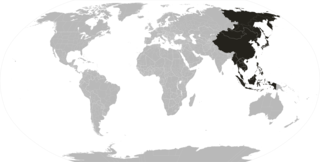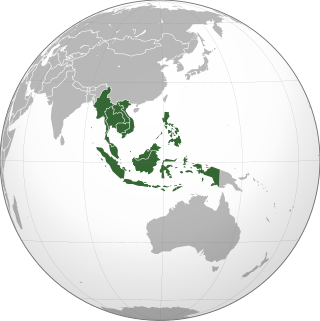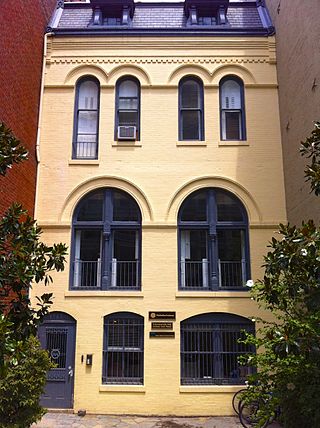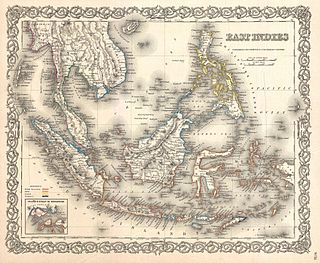Related Research Articles

In European terminology, the Far East is the geographical region that encompasses the easternmost portion of the Asian continent, including East, North and Southeast Asia.

Southeast Asia, also spelled South East Asia and South-East Asia, and also known as Southeastern Asia, South-eastern Asia or SEA, is the geographical south-eastern region of Asia, consisting of the regions that are situated south of mainland China, east of the Indian subcontinent, and north-west of mainland Australia which is part of Oceania. Southeast Asia is bordered to the north by East Asia, to the west by South Asia and the Bay of Bengal, to the east by Oceania and the Pacific Ocean, and to the south by Australia and the Indian Ocean. Apart from the British Indian Ocean Territory and two out of 26 atolls of Maldives in South Asia, Maritime Southeast Asia is the only other subregion of Asia that lies partly within the Southern Hemisphere. Mainland Southeast Asia is completely in the Northern Hemisphere. East Timor and the southern portion of Indonesia are the only parts of Southeast Asia that are south of the Equator.

The Indonesian National Revolution, or the Indonesian War of Independence, was an armed conflict and diplomatic struggle between the Republic of Indonesia and the Dutch Empire and an internal social revolution during postwar and postcolonial Indonesia. It took place between Indonesia's declaration of independence in 1945 and the Netherlands' transfer of sovereignty over the Dutch East Indies to the Republic of the United States of Indonesia at the end of 1949.

The Near East is a transcontinental region around the East Mediterranean encompassing Western Asia, Southeastern Europe and North Africa, including the historical Fertile Crescent, the Levant, Anatolia, East Thrace and Egypt. The term was originally applied to the Ottoman Empire and in relation to the Middle East and the Far East, but today has varying definitions within different academic circles and was previously a separate definition from the Middle East.

The Orient is a term for the East in relation to Europe, traditionally comprising anything belonging to the Eastern world. It is the antonym of Occident, the Western World. In English, it is largely a metonym for, and coterminous with, the continent of Asia, loosely classified into the Southwest Asia, Southeast Asia, South Asia, Central Asia, East Asia, and sometimes including the Caucasus. Originally, the term Orient was used to designate only the Near East, and later its meaning evolved and expanded, designating also Central Asia, Southwest Asia, South Asia, Southeast Asia, or the Far East.

The Greater East Asia Co-Prosperity Sphere, also known as the GEACPS, was a concept that was developed in the Empire of Japan and propagated to Asian populations which it occupied from 1931 to 1945. It officially aimed at creating a self-sufficient bloc of Asian peoples and states that would be led by the Japanese and be free from the rule of Western powers. The idea was first announced on 1 August 1940 in a radio address delivered by Foreign Minister Yōsuke Matsuoka.

A subregion is a part of a larger region or continent and is usually based on location. Cardinal directions, such as south are commonly used to define a subregion.

Hubertus Johannes "Huib" van Mook was a Dutch administrator in the East Indies. During the Indonesian National Revolution, he served as the Acting Governor-General of the Dutch East Indies from 1942 to 1948. Van Mook also had a son named Cornelius van Mook who studied marine engineering at the Massachusetts Institute of Technology. He also wrote about Java - and his work on Kota Gede is a good example of a colonial bureaucrat capable of examining and writing about local folklore.

The Orang Laut are several seafaring ethnic groups and tribes living around Singapore, peninsular Malaysia and the Indonesian Riau Islands. The Orang Laut are commonly identified as the Orang Seletar from the Straits of Johor, but the term may also refer to any Malayic-speaking people living on coastal islands, including those of Mergui Archipelago islands of Myanmar and Thailand, commonly known as Moken.
The Institute of Pacific Relations (IPR) was an international NGO established in 1925 to provide a forum for discussion of problems and relations between nations of the Pacific Rim. The International Secretariat, the center of most IPR activity over the years, consisted of professional staff members who recommended policy to the Pacific Council and administered the international program. The various national councils were responsible for national, regional and local programming. Most participants were members of the business and academic communities in their respective countries. Funding came largely from businesses and philanthropies, especially the Rockefeller Foundation. IPR international headquarters were in Honolulu until the early 1930s when they were moved to New York and the American Council emerged as the dominant national council.
The Association for Asian Studies (AAS) is a scholarly, non-political and non-profit professional association focusing on Asia and the study of Asia. It is based in Ann Arbor, Michigan, United States.

The Middle East Institute (MEI) is a non-profit, non-partisan think tank and cultural centre in Washington, D.C., founded in 1946. It seeks to "increase knowledge of the Middle East among the United States citizens and promote a better understanding between the people of these two areas."
Robert Freiherr von Heine-Geldern, known after 1919 as Robert Heine-Geldern, was a noted Austrian ethnologist, ancient historian, and archaeologist, and a grandnephew of poet Heinrich Heine.
Southeast Asian studies (SEAS) refers to research and education on the language, culture, and history of the different states and ethnic groups of Southeast Asia. Some institutions refer to this discipline as ASEAN Studies since most of the countries that they study belong to the Association of Southeast Asian Nations or ASEAN. Definitions of what constitutes Southeast Asia differ between scholars, which blurs the boundaries between Southeast Asian studies and other regional studies like Oriental studies and post-colonial studies. Southeast Asian studies incorporates anthropology, religious studies, linguistics, and international relations.

The Empire of Japan occupied the Dutch East Indies during World War II from March 1942 until after the end of the war in September 1945. It was one of the most crucial and important periods in modern Indonesian history.

The Eastern world, also known as the East or historically the Orient, is an umbrella term for various cultures or social structures, nations and philosophical systems, which vary depending on the context. It most often includes at least part of Asia or, geographically, the countries and cultures east of Europe, the Mediterranean region and the Arab world, specifically in historical (pre-modern) contexts, and in modern times in the context of Orientalism. It is often seen as a counterpart to the Western world, and correlates strongly to the southern half of the North–South divide.

Indonesia is the common and official name to refer to the Republic of Indonesia or Indonesian archipelago; however, other names, such as Nusantara and East Indies are also known. Some names are considered obsolete and confined to certain periods of history, while some might be more geographically specific or general.

Journal of American-East Asian Relations (JAEAR), according to its website, is a "peer-reviewed quarterly journal of interdisciplinary historical, cross-cultural, and social science scholarship from all parts of the world," which began publication in 1992. The scope includes diplomatic, economic, security, and cultural relations, as well as Asian-American history. Geographical coverage includes the United States, Canada, other countries in the Americas, and East Asia, typically China, Japan, and Korea, but also the Pacific area, Australasia, Southeast Asia, and the Russian Far East.

The first phase of European colonisation of Southeast Asia took place throughout the 16th and 17th centuries. Where new European powers competing to gain monopoly over the spice trade as this trade was very valuable to the Europeans due to high demand for various spices such as pepper, cinnamon, nutmeg, and cloves. This demand led to the arrival of Portuguese, Spanish, Dutch, and later French and British marine spice traders. Fiercely competitive, the Europeans soon sought to eliminate each other by forcibly taking control of the production centres, trade hubs and vital strategic locations, beginning with the Portuguese acquisition of Malacca in 1511. Throughout the 17th and 18th centuries, conquests focused on ports along the maritime routes, that provided a secure passage of maritime trade. It also allowed foreign rulers to levy taxes and control prices of the highly desired Southeast Asian commodities. By the 19th century, all of Southeast Asia had been forced into the various spheres of influence of European global players except Siam, which had served as a convenient buffer state and sandwiched between British Burma and French Indochina. The kings of Siam had to contend with repeated humiliations, accept unequal treaties among massive French and British political interference and territorial losses after the Franco-Siamese War in 1893 and the Anglo-Siamese Treaty of 1909.
References
- "Southeast Asia Institute", The Far Eastern Quarterly, Vol. 5, No. 2 (Feb., 1946), pp. 219–224.
- John Bowen, "The Development of Southeast Asian Studies in the United States", UCIAS Edited Volume 3, The Politics of Knowledge: Area Studies and the Disciplines, 2003.